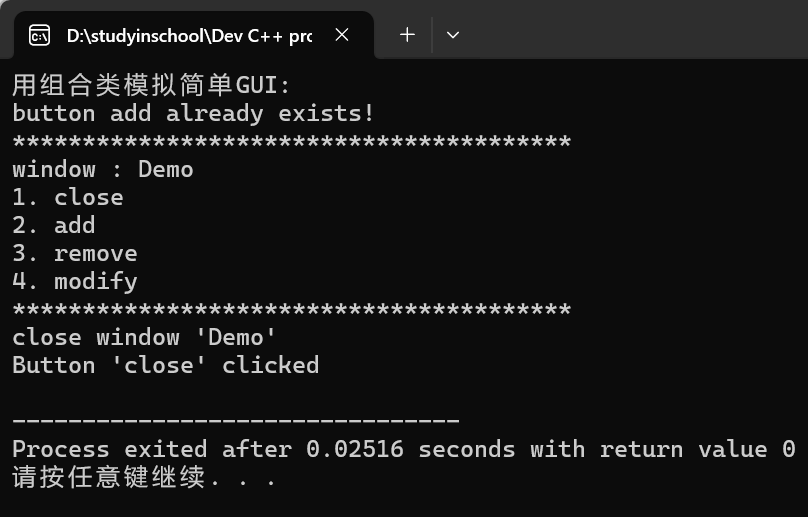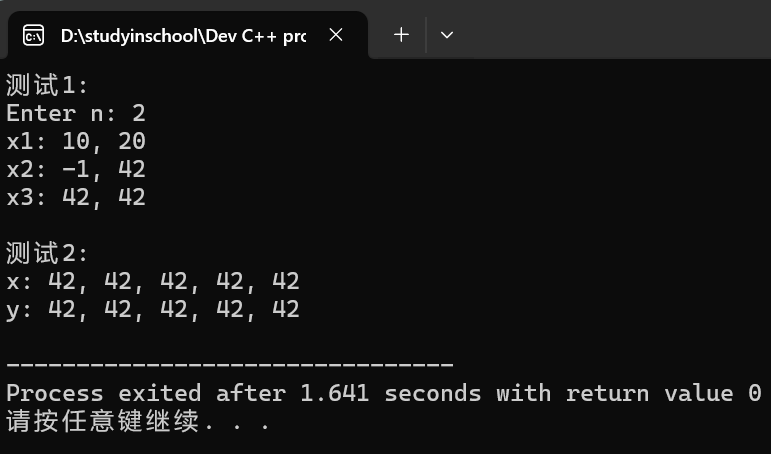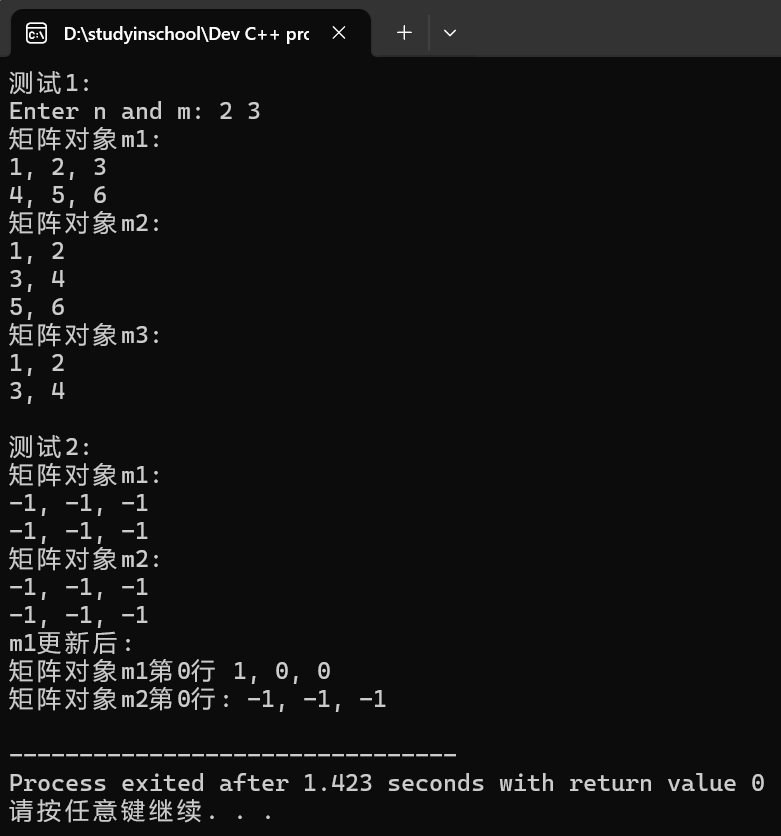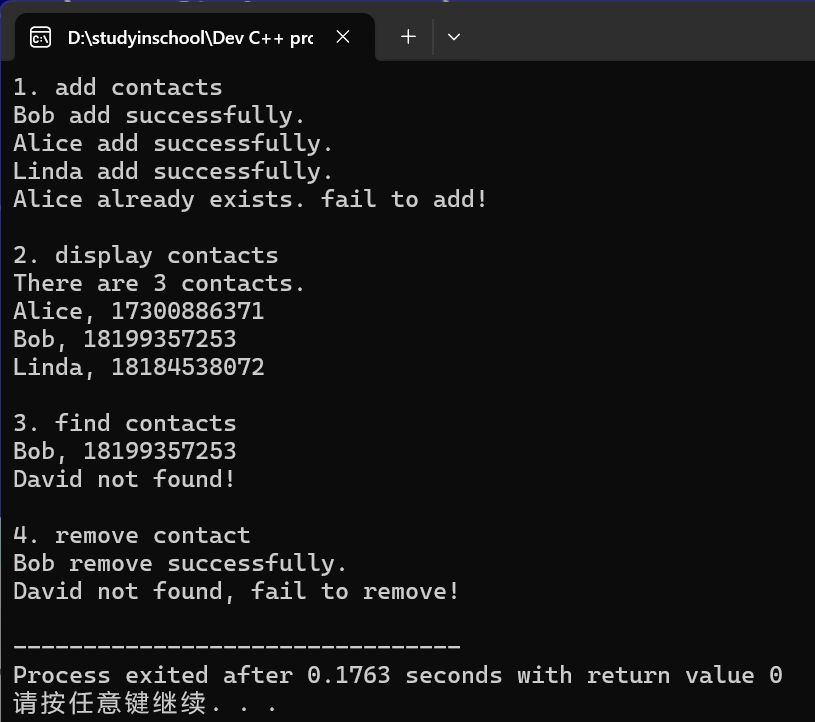实验三
任务一:
1.源代码:
(1)button.hpp:
#pragma once #include <iostream> #include <string> class Button { public: Button(const std::string &label_); const std::string& get_label() const; void click(); private: std::string label; }; Button::Button(const std::string &label_): label{label_} { } inline const std::string& Button::get_label() const { return label; } inline void Button::click() { std::cout << "Button '" << label << "' clicked\n"; }
(2)window.hpp:
#pragma once #include <iostream> #include <vector> #include <algorithm> #include "button.hpp" // 窗口类 class Window{ public: Window(const std::string &title_); void display() const; void close(); void add_button(const std::string &label); void click_button(const std::string &label); private: bool has_button(const std::string &label) const; private: std::string title; std::vector<Button> buttons; }; Window::Window(const std::string &title_): title{title_} { buttons.push_back(Button("close")); } inline void Window::display() const { std::string s(40, '*'); std::cout << s << std::endl; std::cout << "window : " << title << std::endl; int cnt = 0; for(const auto &button: buttons) std::cout << ++cnt << ". " << button.get_label() << std::endl; std::cout << s << std::endl; } inline void Window::close() { std::cout << "close window '" << title << "'" << std::endl; click_button("close"); } inline bool Window::has_button(const std::string &label) const { for(const auto &button: buttons) if(button.get_label() == label) return true; return false; } inline void Window::add_button(const std::string &label) { if(has_button(label)) std::cout << "button " << label << " already exists!\n"; else buttons.push_back(Button(label)); } inline void Window::click_button(const std::string &label) { for(auto &button:buttons) if(button.get_label() == label) { button.click(); return; } std::cout << "no button: " << label << std::endl; }
(3)task1.cpp:
#include "window.hpp" #include <iostream> void test(){ Window w("Demo"); w.add_button("add"); w.add_button("remove"); w.add_button("modify"); w.add_button("add"); w.display(); w.close(); } int main() { std::cout << "用组合类模拟简单GUI:\n"; test(); }
2.实验测试代码运行结果如下:

3.问题回答:
问题一:是;
问题二:(1)优点:共有接口增多,便于类对象在外部直接使用;
风险:如果后续使用该接口过多,如果需要更改这个接口,会导致在外部调用此接口的地方需要对应更改,不利于维护代码;其次,会由于多次调用导致代码重复,累赘,而且在项目复杂情况下,可能会写出具有同样功能的代码,不利于代码的简洁性。
(2)当内部类对于该接口调用较多时,可以封装在内部去使用,即private;根据用户需求,用户不需要去知道代码内部细节,只需要能够正常使用,即可使用public去直接灵活的调用接口;当然,如果类外部使用该方法较少时,也可以使用public,便于灵活使用;如果接口返回对象容易改变的话,可能共有的方法不会很合适。
问题三:接口1返回引用类型,接口2返回普通类型;对于接口1,是在原参数存储地址下更改存储信息,后者类似移动构造,使用另外的存储地址;因此,前者可以改变原变量信息,而后者可以选择性改变(自己赋值给自己),所有相较而言后者更安全。简而言之,前者性能强,后者更安全。
问题四:能正常运行,前者类似复制构造了对象,将其放入容器中;后者是向容器传递生成对象的参数,不会额外占用内存空间(不复制),在容器中构造对象。
任务二:
1.源代码:
(1)task2.cpp:
#include <iostream> #include <vector> void test1(); void test2(); void output1(const std::vector<int> &v); void output2(const std::vector<int> &v); void output3(const std::vector<std::vector<int>>& v); int main() { std::cout << "深复制验证1: 标准库vector<int>\n"; test1(); std::cout << "\n深复制验证2: 标准库vector<int>嵌套使用\n"; test2(); } void test1() { std::vector<int> v1(5, 42); const std::vector<int> v2(v1); std::cout << "**********拷贝构造后**********\n"; std::cout << "v1: "; output1(v1); std::cout << "v2: "; output1(v2); v1.at(0) = -1; std::cout << "**********修改v1[0]后**********\n"; std::cout << "v1: "; output1(v1); std::cout << "v2: "; output1(v2); } void test2() { std::vector<std::vector<int>> v1{{1, 2, 3}, {4, 5, 6, 7}}; const std::vector<std::vector<int>> v2(v1); std::cout << "**********拷贝构造后**********\n"; std::cout << "v1: "; output3(v1); std::cout << "v2: "; output3(v2); v1.at(0).push_back(-1); std::cout << "**********修改v1[0]后**********\n"; std::cout << "v1: \n"; output3(v1); std::cout << "v2: \n"; output3(v2); } // 使用xx.at()+循环输出vector<int>数据项 void output1(const std::vector<int> &v) { if(v.size() == 0) { std::cout << '\n'; return; } std::cout << v.at(0); for(auto i = 1; i < v.size(); ++i) std::cout << ", " << v.at(i); std::cout << '\n'; } // 使用迭代器+循环输出vector<int>数据项 void output2(const std::vector<int> &v) { if(v.size() == 0) { std::cout << '\n'; return; } auto it = v.begin(); std::cout << *it; for(it = v.begin()+1; it != v.end(); ++it) std::cout << ", " << *it; std::cout << '\n'; } // 使用auto for分行输出vector<vector<int>>数据项 void output3(const std::vector<std::vector<int>>& v) { if(v.size() == 0) { std::cout << '\n'; return; } for(auto &i: v) output2(i); }
2.实验测试代码运行结果如下:

3.问题回答:
问题一:
分别完成了带参数构造vector容器、以及复制构造;v1和v2都包含5个值为42的数据项。
问题二:
v1.size()=v2.size()=2;v1[0].size()=3。
问题三:
能实现同等效果,但是两者还是有差异的,使用at()方法可以自动检查索引边界,而[]是不会检查的。
问题四:
(1)能输出-1;因为第一行代码能够给r返回一个v1的第一个vector容器(原v1含有2个vector容器),这样在执行第二行代码时,调用at()方法即相当于在一个vector容器中取对应索引值(最后一个)。
(2)优势:和v1.at(0)绑定,类似指针,所以占用内存资源少,能够提高性能;限制:不能对r进行赋值等改变操作,也就是不能通过r去改变v1的内部数据,而且随着v1的生命周期结束,r也变为空引用。
问题五:
(1)深复制;
(2)int&类型;const int&类型;必须提供,否则非const对象会更改const对象。
任务三:
1.源代码:
(1)task3.cpp:
#include "vectorInt.hpp" #include <iostream> void test1(); void test2(); void output1(const vectorInt &vi); void output2(const vectorInt &vi); int main() { std::cout << "测试1: \n"; test1(); std::cout << "\n测试2: \n"; test2(); } void test1() { int n; std::cout << "Enter n: "; std::cin >> n; vectorInt x1(n); for(auto i = 0; i < n; ++i) x1.at(i) = (i+1)*10; std::cout << "x1: "; output1(x1); vectorInt x2(n, 42); vectorInt x3(x2); x2.at(0) = -1; std::cout << "x2: "; output1(x2); std::cout << "x3: "; output1(x3); } void test2() { const vectorInt x(5, 42); vectorInt y; y.assign(x); std::cout << "x: "; output2(x); std::cout << "y: "; output2(y); } // 使用xx.at()+循环输出vectorInt对象数据项 void output1(const vectorInt &vi) { if(vi.size() == 0) { std::cout << '\n'; return; } std::cout << vi.at(0); for(auto i = 1; i < vi.size(); ++i) std::cout << ", " << vi.at(i); std::cout << '\n'; } // 使用迭代器+循环输出vectorInt对象数据项 void output2(const vectorInt &vi) { if(vi.size() == 0) { std::cout << '\n'; return; } auto it = vi.begin(); std::cout << *it; for(it = vi.begin()+1; it != vi.end(); ++it) std::cout << ", " << *it; std::cout << '\n'; }
(2)vectorInt.hpp:
#pragma once #include <iostream> // 动态int数组对象类 class vectorInt{ public: vectorInt(); vectorInt(int n_); vectorInt(int n_, int value); vectorInt(const vectorInt &vi); ~vectorInt(); int size() const; int& at(int index); const int& at(int index) const; vectorInt& assign(const vectorInt &vi); int* begin(); int* end(); const int* begin() const; const int* end() const; private: int n; // 当前数据项个数 int *ptr; // 数据区 }; vectorInt::vectorInt():n{0}, ptr{nullptr} { } vectorInt::vectorInt(int n_): n{n_}, ptr{new int[n]} { } vectorInt::vectorInt(int n_, int value): n{n_}, ptr{new int[n_]} { for(auto i = 0; i < n; ++i) ptr[i] = value; } vectorInt::vectorInt(const vectorInt &vi): n{vi.n}, ptr{new int[n]} { for(auto i = 0; i < n; ++i) ptr[i] = vi.ptr[i]; } vectorInt::~vectorInt() { delete [] ptr; } int vectorInt::size() const { return n; } const int& vectorInt::at(int index) const { if(index < 0 || index >= n) { std::cerr << "IndexError: index out of range\n"; std::exit(1); } return ptr[index]; } int& vectorInt::at(int index) { if(index < 0 || index >= n) { std::cerr << "IndexError: index out of range\n"; std::exit(1); } return ptr[index]; } vectorInt& vectorInt::assign(const vectorInt &vi) { if(this == &vi) return *this; int *ptr_tmp; ptr_tmp = new int[vi.n]; for(int i = 0; i < vi.n; ++i) ptr_tmp[i] = vi.ptr[i]; delete[] ptr; n = vi.n; ptr = ptr_tmp; return *this; } int* vectorInt::begin() { return ptr; } int* vectorInt::end() { return ptr+n; } const int* vectorInt::begin() const { return ptr; } const int* vectorInt::end() const { return ptr+n; }
2.实验测试代码运行结果如下:

3.问题回答:
问题一:
版本1是先进行分配内存空间操作,后进行复制操作,最后删除,而版本2是先将原来的内存空间给删除了,后进行分配空间和复制操作,如果在内存空间分配失败情况下,第二个版本就会事先丢失原来的数据,及其不安全。
问题二:
(1)将this进行类型转化(非const对象转换为const对象);转换前:vectorInt*,转换后:cosnt vectorInt*;便于非const对象通过转换成const对象后可以调用const函数方法。
(2)将const对象转换为非const对象;转换前:const int&;转换后:int&;使得原本只读的引用变成可写的。
问题三:
(1)v1调用非const版本,v2调用const版本;在需要修改容器元素时,使用非const重载,在只用可读或者访问操作时,使用非const重载。
(2)迭代器可能类似于指针对象。
问题四:
可以,第一行:填充指针对应的n个位置元素为value ;第二行:将vi.ptr容器的vi.n个元素复制到另一个容器ptr中 ;第三行:将vi.ptr容器的vi.n个元素复制到另一个容器ptr_tmp中。
任务四:
1.源代码:
(1)task4.cpp:
#include <iostream> #include <cstdlib> #include "matrix.hpp" void test1(); void test2(); void output(const Matrix &m, int row_index); int main() { std::cout << "测试1: \n"; test1(); std::cout << "\n测试2: \n"; test2(); } void test1() { double x[1000] = {1, 2, 3, 4, 5, 6, 7, 8, 9, 10}; int n, m; std::cout << "Enter n and m: "; std::cin >> n >> m; Matrix m1(n, m); // 创建矩阵对象m1, 大小n×m m1.set(x, n*m); // 用一维数组x的值按行为矩阵m1赋值 Matrix m2(m, n); // 创建矩阵对象m2, 大小m×n m2.set(x, m*n); // 用一维数组x的值按行为矩阵m1赋值 Matrix m3(n); // 创建一个n×n方阵对象 m3.set(x, n*n); // 用一维数组x的值按行为矩阵m3赋值 std::cout << "矩阵对象m1: \n"; m1.print(); std::cout << "矩阵对象m2: \n"; m2.print(); std::cout << "矩阵对象m3: \n"; m3.print(); } void test2() { Matrix m1(2, 3, -1); const Matrix m2(m1); std::cout << "矩阵对象m1: \n"; m1.print(); std::cout << "矩阵对象m2: \n"; m2.print(); m1.clear(); m1.at(0, 0) = 1; std::cout << "m1更新后: \n"; std::cout << "矩阵对象m1第0行 "; output(m1, 0); std::cout << "矩阵对象m2第0行: "; output(m2, 0); } // 输出矩阵对象row_index行所有元素 void output(const Matrix &m, int row_index) { if(row_index < 0 || row_index >= m.rows()) { std::cerr << "IndexError: row index out of range\n"; exit(1); } std::cout << m.at(row_index, 0); for(int j = 1; j < m.cols(); ++j) std::cout << ", " << m.at(row_index, j); std::cout << '\n'; }
(2)matrix.hpp:
#pragma once #include <iostream> #include <algorithm> #include <cstdlib> // 类Matrix声明 class Matrix { public: Matrix(int rows_, int cols_, double value = 0); // 构造rows_*cols_矩阵对象, 初值value Matrix(int rows_, double value = 0); // 构造rows_*rows_方阵对象, 初值value Matrix(const Matrix &x); // 深复制 ~Matrix(); void set(const double *pvalue, int size); // 按行复制pvalue指向的数据,要求size=rows*cols,否则报错退出 void clear(); // 矩阵对象数据项置0 const double& at(int i, int j) const; // 返回矩阵对象索引(i,j)对应的数据项const引用(越界则报错后退出) double& at(int i, int j); // 返回矩阵对象索引(i,j)对应的数据项引用(越界则报错后退出) int rows() const; // 返回矩阵对象行数 int cols() const; // 返回矩阵对象列数 void print() const; // 按行打印数据 private: int n_rows; // 矩阵对象内元素行数 int n_cols; // 矩阵对象内元素列数 double *ptr; // 数据区 };
(3)matrix.cpp:
#include <iostream> #include <algorithm> #include "matrix.hpp" Matrix::Matrix(int rows_, int cols_, double value): n_rows{rows_},n_cols{cols_},ptr{new double[rows_*cols_]}{ std::fill_n(ptr,rows_*cols_,value); } // 构造rows_*cols_矩阵对象, 初值value Matrix::Matrix(int rows_, double value): n_rows{rows_},n_cols{rows_},ptr{new double[rows_*rows_]}{ std::fill_n(ptr,rows_*rows_,value); }// 构造rows_*rows_方阵对象, 初值value Matrix::Matrix(const Matrix &x): n_rows{x.n_rows},n_cols{x.n_cols},ptr{new double[x.n_rows*x.n_cols]}{ std::copy(x.ptr,x.ptr + x.n_rows * x.n_cols,ptr); } // 深复制 Matrix::~Matrix(){ delete[] ptr; } void Matrix::set(const double *pvalue, int size){ if(size != n_rows * n_cols){ std::cerr << "Error\n"; std::exit(1); } for(int i = 0;i < n_rows;i++){ std::copy(pvalue+i*n_cols,pvalue+(i + 1)*n_cols,ptr+i*n_cols); } } // 按行复制pvalue指向的数据,要求size=rows*cols,否则报错退出 void Matrix::clear(){ std::fill_n(ptr,n_rows*n_cols,0); } // 矩阵对象数据项置0 const double& Matrix::at(int i, int j) const{ if(i > n_cols || j > n_rows || i<0 || j<0){ std::cerr << "IndexError: index out of range\n"; std::exit(1); } int a = i * n_cols + j; return *(ptr + a); } // 返回矩阵对象索引(i,j)对应的数据项const引用(越界则报错后退出) double& Matrix::at(int i, int j){ if(i > n_cols || j > n_rows || i<0 || j<0){ std::cerr << "IndexError: index out of range\n"; std::exit(1); } int a = i * n_cols + j; return *(ptr + a); } // 返回矩阵对象索引(i,j)对应的数据项引用(越界则报错后退出) int Matrix::rows() const{ return n_rows; } // 返回矩阵对象行数 int Matrix::cols() const{ return n_cols; } // 返回矩阵对象列数 void Matrix::print() const{ for(int i = 0;i < n_rows;i++){ std::cout << *(ptr + i*n_cols); for(int j = 1;j < n_cols;j++){ std::cout<< ", " << *(ptr + i*n_cols + j); } std::cout << '\n'; } } // 按行打印数据
2.实验测试代码运行结果如下:

任务五:
1.源代码:
(1)task5.cpp:
#include "contactBook.hpp" void test() { ContactBook contactbook; std::cout << "1. add contacts\n"; contactbook.add("Bob", "18199357253"); contactbook.add("Alice", "17300886371"); contactbook.add("Linda", "18184538072"); contactbook.add("Alice", "17300886371"); std::cout << "\n2. display contacts\n"; std::cout << "There are " << contactbook.size() << " contacts.\n"; contactbook.display(); std::cout << "\n3. find contacts\n"; contactbook.find("Bob"); contactbook.find("David"); std::cout << "\n4. remove contact\n"; contactbook.remove("Bob"); contactbook.remove("David"); } int main() { test(); }
(2)contact.hpp:
#pragma once #include <iostream> #include <string> // 联系人类 class Contact { public: Contact(const std::string &name_, const std::string &phone_); const std::string &get_name() const; const std::string &get_phone() const; void display() const; private: std::string name; // 必填项 std::string phone; // 必填项 }; Contact::Contact(const std::string &name_, const std::string &phone_):name{name_}, phone{phone_} { } const std::string& Contact::get_name() const { return name; } const std::string& Contact::get_phone() const { return phone; } void Contact::display() const { std::cout << name << ", " << phone; }
(3)contactBook.hpp:
# pragma once #include <iostream> #include <string> #include <vector> #include <algorithm> #include "contact.hpp" // 通讯录类 class ContactBook { public: void add(const std::string &name, const std::string &phone); // 添加联系人 void remove(const std::string &name); // 移除联系人 void find(const std::string &name) const; // 查找联系人 void display() const; // 显示所有联系人 size_t size() const; private: int index(const std::string &name) const; // 返回联系人在contacts内索引,如不存在,返回-1 void sort(); // 按姓名字典序升序排序通讯录 private: std::vector<Contact> contacts; }; void ContactBook::add(const std::string &name, const std::string &phone) { if(index(name) == -1) { contacts.push_back(Contact(name, phone)); std::cout << name << " add successfully.\n"; sort(); return; } std::cout << name << " already exists. fail to add!\n"; } void ContactBook::remove(const std::string &name) { int i = index(name); if(i == -1) { std::cout << name << " not found, fail to remove!\n"; return; } contacts.erase(contacts.begin()+i); std::cout << name << " remove successfully.\n"; } void ContactBook::find(const std::string &name) const { int i = index(name); if(i == -1) { std::cout << name << " not found!\n"; return; } contacts[i].display(); std::cout << '\n'; } void ContactBook::display() const { for(auto &c: contacts) { c.display(); std::cout << '\n'; } } size_t ContactBook::size() const { return contacts.size(); } // 待补足1:int index(const std::string &name) const;实现 // 返回联系人在contacts内索引; 如不存在,返回-1 int ContactBook::index(const std::string &name) const{ for(const auto& con : contacts) { if(con.get_name() == name){ return &con - &contacts[0]; } } return -1; } // 待补足2:void ContactBook::sort();实现 // 按姓名字典序升序排序通讯录 void ContactBook::sort(){ // 使用lambda表达式按name排序 std::sort(contacts.begin(), contacts.end(), [](const Contact& a, const Contact& b) { return a.get_name() < b.get_name(); }); }
2.实验测试代码运行结果如下:

实验总结:
(1)深复制是给新对象分配一个新的内存空间,该内存空间的所有属性,数据,内容等,都是复制的复制对象的内容;而浅复制是共有一个地址(内存空间),所以这样会导致两者“绑定”效果;
(2)巧用c++的标准库,可以简化很多代码,且更便利于实现逻辑功能,是开发更快速,安全;
(3)对于存储数据*ptr,可以使用容器vector等去存储,这样更代码更加精简,而且对于vector有现成的算法库可以调用,更加快捷,安全,利于理解,提高了开发效率;
(4)Lambda表达式可以对vector<对象>将对象中的属性进行遍历,比较,这样简化了代码,更利于代码整洁性,而且如果能够掌握这样的编程方式,对于编程速度也能大幅提升。





 浙公网安备 33010602011771号
浙公网安备 33010602011771号